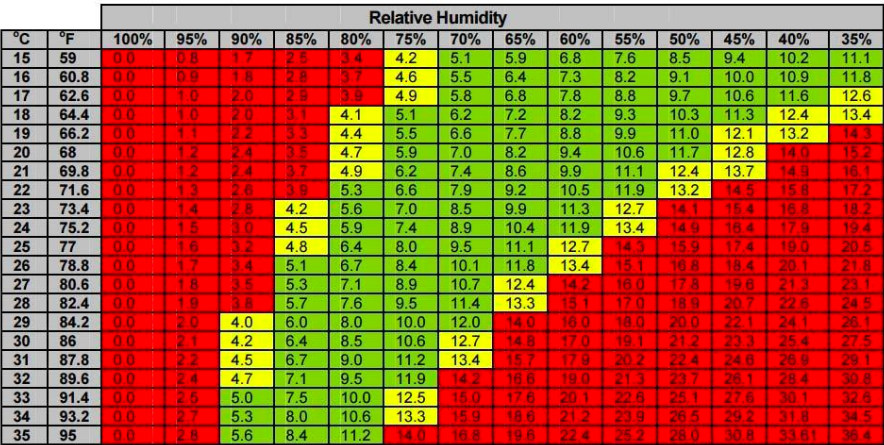Understanding VPD
Vapour Pressure Deficit or VPD is the measure of how much remaining moisture the air can hold. This is important in an indoor garden because it lets you determine the best temperature and humidity for your grow room. VPD is different from relative humidity, which is the measure of how much water is in the air, and not just what it is capable of holding.
How to Calculate VPD
Calculating the actual VPD is done with a complicated equation that is derived from the Arrhenius equation. This formula is used to determine the capacity that the air has to hold water at a certain temperature. You then can subtract the amount of water that is in the air, or you can just skip all of those steps and use a chart where someone already worked out all of the values. By knowing the relative humidity or the temperature, you can plot it on the graph and find out the value that you are missing.
For example, if your humidity is 65%, then your ideal temperatures are between 68°f and 75 °f. Using this method to optimize the transportation of your grow room can lead to bigger plants with a much greater thirst for nutrients. The ideal VPD is between 0.8 and 0.95 kPa, so find a spot that matches your room conditions with the highest VPD possible.

VPD can be useful for determining grow room conditions, but it is still important to consider the ideal ranges for your crop. Don’t exceed the maximum temperature that your plants can handle, or you’ll risk damaging your crop. The ideal temperatures for most plants is between 70 °f and 80 °f, depending on variety. Whether you are just starting or upgrading, VPD is useful for planning your next grow, or helping to dial in your current one.
How to Adjust VPD
The environment is the most important part of growing a healthy crop. Adjusting your VPD can be done by changing your humidity or temperatures. Controlling your environmental conditions can be done a few different ways.
- A mini split air conditioner with a heat pump can be used to heat or cool your room depending on the outside weather. A mini split can also function as a dehumidification unit and be used to pull water out of the air.
- In large gardens dedicated dehumidifiers may be necessary. When your plants are small and do not transpire much it may be necessary to mist them or add a humidifier to bring the relative humidity up to where it needs to be.
What does this all mean for your garden? Well, when your VPD is wrong, your plants are limited in their ability to uptake water and nutrients. If you can maximize the uptake of your plants you can optimize the yields for your crop and maximize your harvest.
 Commercial Grower?
Commercial Grower?


